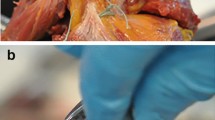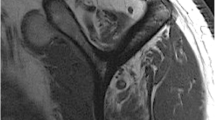Abstract
Introduction
Latissimus dorsi and teres major (LDTM) tendon transfer has demonstrated better clinical outcomes compared to Latissimus dorsi (LD) transfer for irreparable anterosuperior cuff (subscapularis/supraspinatus) tears; however, the biomechanical effects of these procedures are unknown. Therefore, the objective of this study was to compare kinematics and internal rotation of LDTM transfer to LD transfer for anterosuperior cuff tear.
Methods
Eight cadaveric shoulders were tested in four conditions; (1) intact, (2) anterosuperior rotator cuff tear, (3) LDTM transfer, and (4) LD transfer. Glenohumeral kinematics and internal rotation at 0°, 30°, and 60° of glenohumeral abduction in the scapular plane were measured. Muscle loading was applied based on physiological cross-sectional area ratios with three muscle loading conditions to simulate potentially increased tension due to the advanced insertion site of the transferred tendons.
Results
The anterosuperior rotator cuff tear leads to a significant superior shift of the humeral head compared to intact at 0° and 30° abduction (p < 0.039). Both the LDTM (p < 0.047) and LD transfers (p < 0.032) significantly shifted the humeral head inferiorly compared to the tear condition.; however, the LDTM transfer shifted the head in the anteroinferior direction compared to the LD transfer at 60° abduction and 30° ER (p < 0.045). Both LDTM and LD transfer significantly increased internal resting rotation (p < 0.008) and maximum internal rotation (p < 0.008) compared to anterosuperior rotator cuff tear and intact at 30° and 60° abduction. LDTM transfer resulted in a significant internal resting rotation compared with the LD transfer at 30° abduction with double muscle loading (p = 0.02). At 0° abduction, the LDTM transfer (p < 0.027) significantly increased maximum internal rotation compared to anterosuperior rotator cuff tear and intact.
Conclusion
Although both LDTM and LD tendon transfer improved the abnormal humeral head apex position and internal rotation compared with the tear condition, the LDTM transfer was biomechanically superior to the LD transfer in a cadaveric model.


Similar content being viewed by others
Data availability
The data that support the findings of this study are available from the corresponding author upon reasonable request.
References
Bennett WF (2003) Arthroscopic repair of anterosuperior (supraspinatus/subscapularis) rotator cuff tears: a prospective cohort with 2- to 4-year follow-up. Classification of biceps subluxation/instability. Arthroscopy 19(1):21–33. https://doi.org/10.1053/jars.2003.50023
Warner JJ, Higgins L, Parsons IMT, Dowdy P (2001) Diagnosis and treatment of anterosuperior rotator cuff tears. J Shoulder Elbow Surg 10(1):37–46. https://doi.org/10.1067/mse.2001.112022
Gerber C, Hersche O, Farron A (1996) Isolated rupture of the subscapularis tendon. J Bone Joint Surg Am 78(7):1015–1023. https://doi.org/10.2106/00004623-199607000-00005
Gerber C, Krushell RJ (1991) Isolated rupture of the tendon of the subscapularis muscle. Clinical features in 16 cases. J Bone Joint Surg British Vol 73(3):389–94. https://doi.org/10.1302/0301-620x.73b3.1670434
Elhassan B, Christensen TJ, Wagner ER (2014) Feasibility of latissimus and teres major transfer to reconstruct irreparable subscapularis tendon tear: an anatomic study. J Shoulder Elbow Surg 23(4):492–499. https://doi.org/10.1016/j.jse.2013.07.046
Elhassan BT, Wagner ER, Kany J (2020) Latissimus dorsi transfer for irreparable subscapularis tear. J Shoulder Elbow Surg 29(10):2128–2134. https://doi.org/10.1016/j.jse.2020.02.019
Kany J, Guinand R, Croutzet P, Valenti P, Werthel JD, Grimberg J (2016) Arthroscopic-assisted latissimus dorsi transfer for subscapularis deficiency. Eur J Orthop Surg Traumatol 26(3):329–334. https://doi.org/10.1007/s00590-016-1753-3
Mun SW, Kim JY, Yi SH, Baek CH (2018) Latissimus dorsi transfer for irreparable subscapularis tendon tears. J Shoulder Elbow Surg 27(6):1057–1064. https://doi.org/10.1016/j.jse.2017.11.022
Werthel JD, Schoch BS, Hooke A, Sperling JW, An KN, Valenti P et al (2021) Biomechanical effectiveness of tendon transfers to restore active internal rotation in shoulder with deficient subscapularis with and without reverse shoulder arthroplasty. J Shoulder Elbow Surg 30(5):1196–1206. https://doi.org/10.1016/j.jse.2020.08.026
Abzug JM, Miller E, Case AL, Hogarth DA, Zlotolow DA, Kozin SH (2022) Single versus double tendon transfer to improve shoulder external rotation during the treatment of brachial plexus birth palsy. Hand (New York, NY) 17(1):55–59. https://doi.org/10.1177/1558944720911211
Greenhill DA, Smith WR, Ramsey FV, Kozin SH, Zlotolow DA (2019) Double versus single tendon transfers to improve shoulder function in brachial plexus birth palsy. J Pediatr Orthop 39(6):328–334. https://doi.org/10.1097/bpo.0000000000000965
L'Episcopo JJTAJoS (1934) Tendon transplantation in obstetrical paralysis. 25(1):122–125
Lichtenberg S, Magosch P, Habermeyer P (2012) Are there advantages of the combined latissimus-dorsi transfer according to L’Episcopo compared to the isolated latissimus-dorsi transfer according to Herzberg after a mean follow-up of 6 years? A matched-pair analysis. J Shoulder Elbow Surg 21(11):1499–1507. https://doi.org/10.1016/j.jse.2012.01.002
Boileau P, Chuinard C, Roussanne Y, Neyton L, Trojani C (2007) Modified latissimus dorsi and teres major transfer through a single delto-pectoral approach for external rotation deficit of the shoulder: as an isolated procedure or with a reverse arthroplasty. J Shoulder Elbow Surg 16(6):671–682. https://doi.org/10.1016/j.jse.2007.02.127
Codman EA (1934) The shoulder: rupture of the supraspinatus tendon and other lesions in or about the subacromial bursa. Thomas Todd, Boston
Halder AM, Zhao KD, Odriscoll SW, Morrey BF, An KN (2001) Dynamic contributions to superior shoulder stability. J Orthop Resh 19(2):206–212. https://doi.org/10.1016/s0736-0266(00)00028-0
Mulla DM, Hodder JN, Maly MR, Lyons JL, Keir PJ (2020) Glenohumeral stabilizing roles of the scapulohumeral muscles: Implications of muscle geometry. J Biomech 100:109589. https://doi.org/10.1016/j.jbiomech.2019.109589
Lee YS, Lee TQ (2010) Specimen-specific method for quantifying glenohumeral joint kinematics. Ann Biomed Eng 38(10):3226–3236. https://doi.org/10.1007/s10439-010-0074-7
Akagi R, Kanehisa H, Kawakami Y, Fukunaga T (2008) Establishing a new index of muscle cross-sectional area and its relationship with isometric muscle strength. J Strength Cond Res 22(1):82–87. https://doi.org/10.1519/JSC.0b013e31815ef675
Veeger HE, Van der Helm FC, Van der Woude LH, Pronk GM, Rozendal RH (1991) Inertia and muscle contraction parameters for musculoskeletal modelling of the shoulder mechanism. J Biomech 24(7):615–629. https://doi.org/10.1016/0021-9290(91)90294-w
Youm T, ElAttrache NS, Tibone JE, McGarry MH, Lee TQ (2009) The effect of the long head of the biceps on glenohumeral kinematics. J Shoulder Elbow Surg 18(1):122–129. https://doi.org/10.1016/j.jse.2008.06.003
Oh JH, Tilan J, Chen YJ, Chung KC, McGarry MH, Lee TQ (2013) Biomechanical effect of latissimus dorsi tendon transfer for irreparable massive cuff tear. J Shoulder Elbow Surg 22(2):150–157. https://doi.org/10.1016/j.jse.2012.01.022
Omid R, Heckmann N, Wang L, McGarry MH, Vangsness CT Jr, Lee TQ (2015) Biomechanical comparison between the trapezius transfer and latissimus transfer for irreparable posterosuperior rotator cuff tears. J Shoulder Elbow Surg 24(10):1635–1643. https://doi.org/10.1016/j.jse.2015.02.008
Collin P, Lädermann A, Le Bourg M, Walch G (2013) Subscapularis minor–an analogue of the Teres minor? Orthop Traumatol Surg Res OTSR 99(4 Suppl):S255–S258. https://doi.org/10.1016/j.otsr.2013.03.003
Gerber C, Schneeberger AG, Beck M, Schlegel U (1994) Mechanical strength of repairs of the rotator cuff. J Bone Joint Surg British Vol 76(3):371–380
Su WR, Budoff JE, Luo ZP (2009) The effect of anterosuperior rotator cuff tears on glenohumeral translation. Arthroscopy 25(3):282–289. https://doi.org/10.1016/j.arthro.2008.10.005
Kedgley AE, Mackenzie GA, Ferreira LM, Johnson JA, Faber KJ (2007) In vitro kinematics of the shoulder following rotator cuff injury. Clin Biomech (Bristol, Avon) 22(10):1068–1073. https://doi.org/10.1016/j.clinbiomech.2007.06.005
Yoo JC, McGarry MH, Jun BJ, Scott J, Lee TQ (2014) The influence of partial subscapularis tendon tears combined with supraspinatus tendon tears. J Shoulder Elbow Surg 23(6):902–908. https://doi.org/10.1016/j.jse.2013.09.015
Gerber C, Maquieira G, Espinosa N (2006) Latissimus dorsi transfer for the treatment of irreparable rotator cuff tears. J Bone Joint Surg Am 88(1):113–120. https://doi.org/10.2106/jbjs.E.00282
Básica B, Rouviere H, Delmas A (1999) Anatomía Humana: descriptiva, topográfica y funcional. 10th edición. Ed. Masson. Barcelona
Dancker M, Lambert S, Brenner E (2017) Teres major muscle - insertion footprint. J Anat 230(5):631–638. https://doi.org/10.1111/joa.12593
Baek CH, Kim JG, Baek GR (2022) Outcomes of combined anterior latissimus dorsi and teres major tendon transfer for irreparable anterosuperior rotator cuff tears. J Shoulder Elbow Surg 31(11):2298–2307. https://doi.org/10.1016/j.jse.2022.03.025
Funding
Funding for this study was provided by Yeosu Baek Hospital, Yeosu-si, Jeollanam-do, Republic of Korea. The funding source did not play a role in the investigation.
Author information
Authors and Affiliations
Contributions
All authors contributed to the study’s conception and design. Methodology: Michelle H. McGarry, MS; Gregory J. Adamson, MD; Thay Q Lee, PhD; Data collection and analysis were performed by Gyu Rim Baek, BS; Jung Gon Kim, MD; Andrew P. Nakla, BS; Daniel Kwak, BA; Min-Shik Chung, BS, Michelle H. McGarry, MS. Funding acquisition: Gregory J. Adamson, MD1; Thay Q Lee, PhD1 The first draft of the manuscript was written by Gyu Rim Baek, BS and Jung Gon Kim, MD and all authors commented on previous versions of the manuscript. All authors read and approved the final manuscript. Investigation performed at Orthopaedic Biomechanics Laboratory, Congress Medical Foundation, Pasadena, CA, USA.
Corresponding author
Ethics declarations
Conflict of interest
The authors have no relevant financial or non-financial interests to disclose.
Ethical approval
Institutional review board approval was not required for this cadaveric study.
Informed consent
NA as this was a basic science cadaveric study.
Additional information
Publisher's Note
Springer Nature remains neutral with regard to jurisdictional claims in published maps and institutional affiliations.
Rights and permissions
Springer Nature or its licensor (e.g. a society or other partner) holds exclusive rights to this article under a publishing agreement with the author(s) or other rightsholder(s); author self-archiving of the accepted manuscript version of this article is solely governed by the terms of such publishing agreement and applicable law.
About this article
Cite this article
Baek, G.R., Kim, J.G., Nakla, A.P. et al. Latissimus dorsi and teres major tendon transfer for irreparable anterosuperior rotator cuff tear improves kinematics and internal rotation compared to latissimus dorsi tendon transfer. Arch Orthop Trauma Surg 143, 4731–4739 (2023). https://doi.org/10.1007/s00402-022-04735-4
Received:
Accepted:
Published:
Issue Date:
DOI: https://doi.org/10.1007/s00402-022-04735-4




